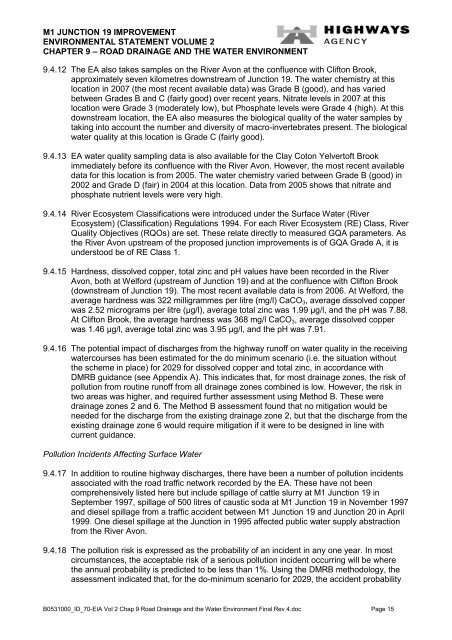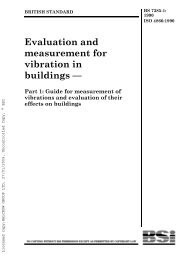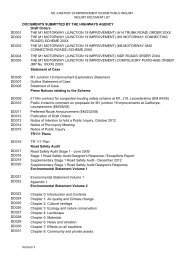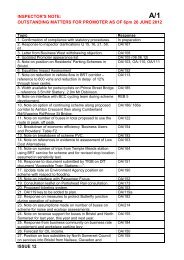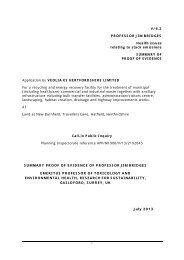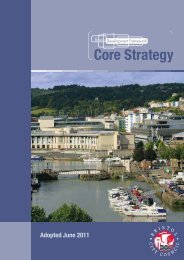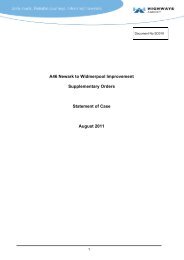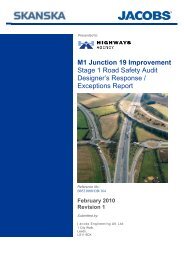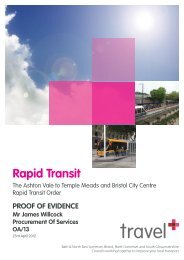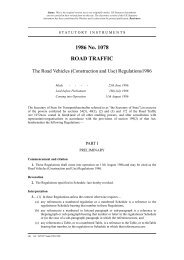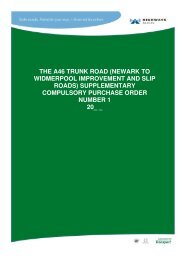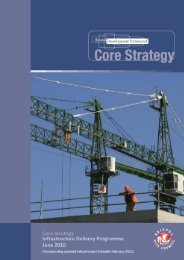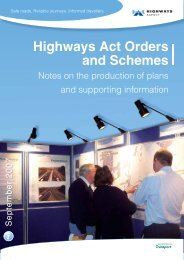Chapter 9: Road drainage and the water environment
Chapter 9: Road drainage and the water environment
Chapter 9: Road drainage and the water environment
You also want an ePaper? Increase the reach of your titles
YUMPU automatically turns print PDFs into web optimized ePapers that Google loves.
M1 JUNCTION 19 IMPROVEMENT<br />
ENVIRONMENTAL STATEMENT VOLUME 2<br />
CHAPTER 9 – ROAD DRAINAGE AND THE WATER ENVIRONMENT<br />
9.4.12 The EA also takes samples on <strong>the</strong> River Avon at <strong>the</strong> confluence with Clifton Brook,<br />
approximately seven kilometres downstream of Junction 19. The <strong>water</strong> chemistry at this<br />
location in 2007 (<strong>the</strong> most recent available data) was Grade B (good), <strong>and</strong> has varied<br />
between Grades B <strong>and</strong> C (fairly good) over recent years. Nitrate levels in 2007 at this<br />
location were Grade 3 (moderately low), but Phosphate levels were Grade 4 (high). At this<br />
downstream location, <strong>the</strong> EA also measures <strong>the</strong> biological quality of <strong>the</strong> <strong>water</strong> samples by<br />
taking into account <strong>the</strong> number <strong>and</strong> diversity of macro-invertebrates present. The biological<br />
<strong>water</strong> quality at this location is Grade C (fairly good).<br />
9.4.13 EA <strong>water</strong> quality sampling data is also available for <strong>the</strong> Clay Coton Yelvertoft Brook<br />
immediately before its confluence with <strong>the</strong> River Avon. However, <strong>the</strong> most recent available<br />
data for this location is from 2005. The <strong>water</strong> chemistry varied between Grade B (good) in<br />
2002 <strong>and</strong> Grade D (fair) in 2004 at this location. Data from 2005 shows that nitrate <strong>and</strong><br />
phosphate nutrient levels were very high.<br />
9.4.14 River Ecosystem Classifications were introduced under <strong>the</strong> Surface Water (River<br />
Ecosystem) (Classification) Regulations 1994. For each River Ecosystem (RE) Class, River<br />
Quality Objectives (RQOs) are set. These relate directly to measured GQA parameters. As<br />
<strong>the</strong> River Avon upstream of <strong>the</strong> proposed junction improvements is of GQA Grade A, it is<br />
understood be of RE Class 1.<br />
9.4.15 Hardness, dissolved copper, total zinc <strong>and</strong> pH values have been recorded in <strong>the</strong> River<br />
Avon, both at Welford (upstream of Junction 19) <strong>and</strong> at <strong>the</strong> confluence with Clifton Brook<br />
(downstream of Junction 19). The most recent available data is from 2006. At Welford, <strong>the</strong><br />
average hardness was 322 milligrammes per litre (mg/l) CaCO 3 , average dissolved copper<br />
was 2.52 micrograms per litre (µg/l), average total zinc was 1.99 µg/l, <strong>and</strong> <strong>the</strong> pH was 7.88.<br />
At Clifton Brook, <strong>the</strong> average hardness was 368 mg/l CaCO 3 , average dissolved copper<br />
was 1.46 µg/l, average total zinc was 3.95 µg/l, <strong>and</strong> <strong>the</strong> pH was 7.91.<br />
9.4.16 The potential impact of discharges from <strong>the</strong> highway runoff on <strong>water</strong> quality in <strong>the</strong> receiving<br />
<strong>water</strong>courses has been estimated for <strong>the</strong> do minimum scenario (i.e. <strong>the</strong> situation without<br />
<strong>the</strong> scheme in place) for 2029 for dissolved copper <strong>and</strong> total zinc, in accordance with<br />
DMRB guidance (see Appendix A). This indicates that, for most <strong>drainage</strong> zones, <strong>the</strong> risk of<br />
pollution from routine runoff from all <strong>drainage</strong> zones combined is low. However, <strong>the</strong> risk in<br />
two areas was higher, <strong>and</strong> required fur<strong>the</strong>r assessment using Method B. These were<br />
<strong>drainage</strong> zones 2 <strong>and</strong> 6. The Method B assessment found that no mitigation would be<br />
needed for <strong>the</strong> discharge from <strong>the</strong> existing <strong>drainage</strong> zone 2, but that <strong>the</strong> discharge from <strong>the</strong><br />
existing <strong>drainage</strong> zone 6 would require mitigation if it were to be designed in line with<br />
current guidance.<br />
Pollution Incidents Affecting Surface Water<br />
9.4.17 In addition to routine highway discharges, <strong>the</strong>re have been a number of pollution incidents<br />
associated with <strong>the</strong> road traffic network recorded by <strong>the</strong> EA. These have not been<br />
comprehensively listed here but include spillage of cattle slurry at M1 Junction 19 in<br />
September 1997, spillage of 500 litres of caustic soda at M1 Junction 19 in November 1997<br />
<strong>and</strong> diesel spillage from a traffic accident between M1 Junction 19 <strong>and</strong> Junction 20 in April<br />
1999. One diesel spillage at <strong>the</strong> Junction in 1995 affected public <strong>water</strong> supply abstraction<br />
from <strong>the</strong> River Avon.<br />
9.4.18 The pollution risk is expressed as <strong>the</strong> probability of an incident in any one year. In most<br />
circumstances, <strong>the</strong> acceptable risk of a serious pollution incident occurring will be where<br />
<strong>the</strong> annual probability is predicted to be less than 1%. Using <strong>the</strong> DMRB methodology, <strong>the</strong><br />
assessment indicated that, for <strong>the</strong> do-minimum scenario for 2029, <strong>the</strong> accident probability<br />
B0531000_ID_70-EIA Vol 2 Chap 9 <strong>Road</strong> Drainage <strong>and</strong> <strong>the</strong> Water Environment Final Rev 4.doc Page 15


